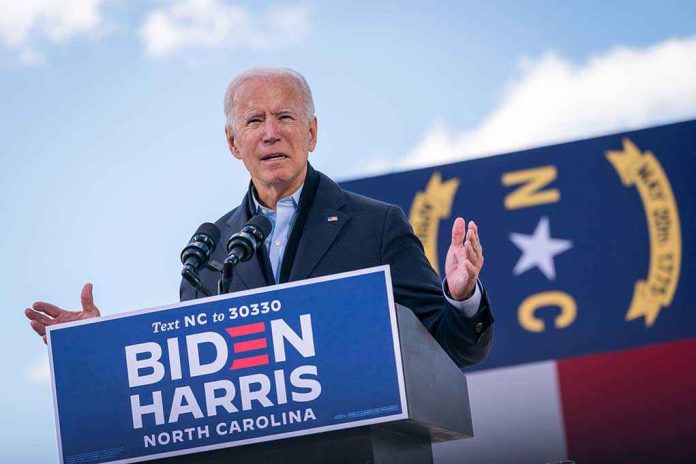
The Biden administration rushed through a staggering $42 billion in green energy loans during its final two days in office, deliberately circumventing warnings from its own inspector general about potential conflicts of interest.
Key Takeaways
- Biden’s Energy Department approved nearly $42 billion for green energy projects in just two days, exceeding the total amount disbursed by its Loan Programs Office over the past decade
- The administration deliberately ignored warnings from the department’s inspector general about potential conflicts of interest in post-election loan approvals
- Several approved projects are already facing financial difficulties, reminiscent of the Solyndra bankruptcy scandal during the Obama administration
- The Trump administration is reviewing these hastily approved loans and plans to redirect remaining funds toward nuclear projects and other energy priorities
- Approximately $300 billion in loan authority remains uncommitted, offering President Trump an opportunity to reshape America’s energy priorities
Last-Minute Green Energy Spending Spree
Following Vice President Kamala Harris’s decisive loss in the 2024 election, the Biden administration embarked on a frantic effort to allocate billions in taxpayer dollars before President Trump could take office. The Energy Department’s Loan Programs Office (LPO) approved nearly $42 billion for green energy projects in its final two working days alone, a figure that surpasses the total amount disbursed by the office over the entire previous decade. This hasty allocation occurred despite explicit warnings from the department’s own inspector general about the impropriety of making such massive financial commitments after an election.
“It is extremely concerning how many dozens of billions of dollars were rushed out the door without proper due diligence in the final days of the Biden administration,” said Chris Wright, Energy Secretary .
The Biden administration’s last-minute spending spree targeted politically favored green energy initiatives including rooftop solar installations, battery recycling efforts, and electric vehicle production. The funds originated from the 2022 Inflation Reduction Act, which allocated an unprecedented $400 billion to the LPO, dramatically increasing its lending capacity. Despite the rush to commit funds before the transition of power, approximately $300 billion remains uncommitted, providing President Trump with significant financial resources to redirect toward his energy priorities.
Troubled Projects Raising Red Flags
Several of the hastily approved projects have already encountered serious financial and operational difficulties, raising concerns about the viability of these investments and the potential for massive taxpayer losses. This pattern bears a disturbing resemblance to the notorious Solyndra scandal during the Obama administration, when a politically connected solar panel manufacturer received $535 million in federal loan guarantees before declaring bankruptcy. Among the concerning projects are Sunnova, Li-Cycle, Zum Energy, and Blue Oval SK, with some companies either filing for bankruptcy or facing significant operational challenges.
The Biden administration’s rush to distribute these funds appears to have been motivated more by political considerations than sound financial judgment. By modifying LPO regulations to make loan approvals easier, the administration potentially compromised taxpayer protections in favor of accelerating green energy initiatives. This regulatory relaxation came despite historical evidence that government-backed green energy ventures often fail to deliver promised results while putting taxpayer dollars at significant risk.
Trump Administration’s Response
President Trump’s administration is conducting a comprehensive review of these financial commitments, with particular focus on the lack of due diligence and potential waste of taxpayer dollars. While the administration has expressed commitment to maintaining the Loan Programs Office, it aims to improve operations and redirect resources toward projects that align with America’s energy security and economic interests, particularly nuclear energy development. The review process may result in the cancellation of some deals, with new guidelines requiring more thorough evaluations of project viability.
“The loan office should not be in the virtual venture business, but in a few cases, it could make sense to serve as a catalyst or backstop for viable and important projects from a national security or policy perspective,” said Mark Mills, executive director of the National Center on Energy Analytics.
Some loan recipients are defending the necessity of government backing for their projects, particularly those involved in critical minerals development. The argument centers on competition with China, which provides substantial financial support to its own critical minerals industry. “Ioneer believes government policy should encourage projects if we want critical minerals developed domestically. Time is the key risk for development as China continues to provide financial support to its critical minerals industry and dump critical minerals into the market thereby depressing the price,” said Chad Yeftich, Pioneer vice President .
Future Implications for Energy Policy
The Biden administration’s last-minute green energy funding blitz underscores the stark differences in energy policy approaches between the previous and current administrations. While Biden prioritized climate initiatives and renewable energy at virtually any cost, President Trump has consistently emphasized energy independence, domestic production, and economic viability. The remaining $300 billion in loan authority represents a significant opportunity for the Trump administration to reshape America’s energy landscape according to these priorities, with particular emphasis on revitalizing nuclear energy and supporting fossil fuel development.
As the review process unfolds, taxpayers can expect increased scrutiny and transparency in how these federal loan programs operate. The Trump administration’s approach aims to balance legitimate national interests in energy security with responsible fiscal management, ensuring that future energy investments serve America’s needs rather than political agendas. This shift represents a welcome return to pragmatic energy policy after years of ideologically driven decision-making that prioritized climate symbolism over practical results and economic realities.





